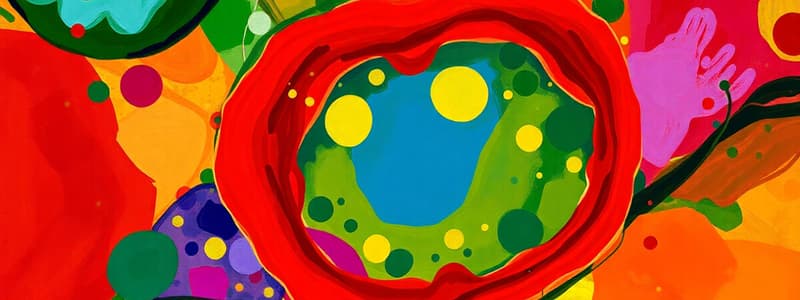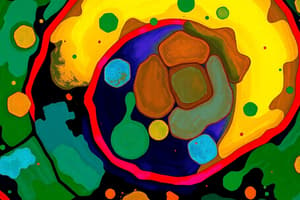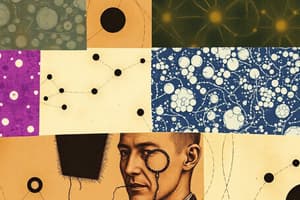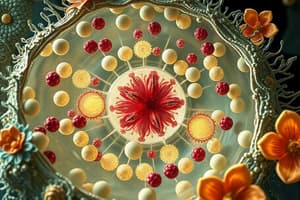Podcast
Questions and Answers
What is the primary function of the rough endoplasmic reticulum?
What is the primary function of the rough endoplasmic reticulum?
- Digest toxic materials
- Store food and nutrients
- Synthesize and pack proteins (correct)
- Provide structural support
Which of the following organelles is found only in animal cells?
Which of the following organelles is found only in animal cells?
- Ribosome
- Peroxisome
- Vacuole
- Lysosome (correct)
What is the role of microtubules in a cell?
What is the role of microtubules in a cell?
- Synthesize proteins
- Store nutrients
- Digest nutrients and toxins
- Provide structure and aid in cell division (correct)
How do vacuoles differ between plant and animal cells?
How do vacuoles differ between plant and animal cells?
What is the primary composition of centrioles?
What is the primary composition of centrioles?
What is the role of the cell membrane in both plant and animal cells?
What is the role of the cell membrane in both plant and animal cells?
Which organelle is responsible for photosynthesis and is found only in plant cells?
Which organelle is responsible for photosynthesis and is found only in plant cells?
What function does mitochondria serve in both plant and animal cells?
What function does mitochondria serve in both plant and animal cells?
What is a major structural difference between plant and animal cells?
What is a major structural difference between plant and animal cells?
What is the function of the Golgi apparatus in a cell?
What is the function of the Golgi apparatus in a cell?
Which statement is true about the cytoplasm?
Which statement is true about the cytoplasm?
What is the primary purpose of the cell wall in plant cells?
What is the primary purpose of the cell wall in plant cells?
Which organelle that is found in both plant and animal cells is involved in lipid synthesis?
Which organelle that is found in both plant and animal cells is involved in lipid synthesis?
Flashcards are hidden until you start studying
Study Notes
Cell Membrane
- The cell membrane is a layer in both plant and animal cells.
- It helps keep fluids and organelles inside the cell.
- It acts as a "security guard" for the cell.
- The cell membrane has small holes that allow certain molecules to enter the cell and prevents harmful molecules from entering.
Cell Wall
- The cell wall is the outer layer of plant cells.
- It helps protect everything inside the cell.
- The cell wall is made of strong materials that keep harmful substances outside the cell.
Cytoplasm
- Cytoplasm is the fluid that fills a cell.
- It’s present in both plant and animal cells.
- Cytoplasm is made up of dissolved molecules that are used in various cellular processes.
Nucleus
- The nucleus is the "control center" of plant and animal cells.
- It controls growth and reproduction.
- It is located near the center of the cell and contains the cell's chromosomes.
Nucleolus
- The nucleolus is a structure found inside the nucleus of both plant and animal cells.
- It is made up of RNA and protein.
- It looks like a nucleus inside a nucleus.
Chloroplast
- Chloroplast converts light energy from the sun into sugars that can be used by cells.
- It is the organelle where photosynthesis takes place.
- It is only found in plant cells.
Mitochondria
- Mitochondria perform cellular respiration, the process of breaking down nutrients into energy for the cell.
- It is found in both plant and animal cells.
- It is known as the "powerhouse" of the cell.
Golgi Apparatus
- The Golgi apparatus converts combinations of molecules into new, more complex molecules.
- It then sends these molecules out of the cell or stores them.
- It is found in both plant and animal cells.
Smooth Endoplasmic Reticulum (E.R.)
- The smooth E.R. is an organelle attached to the nucleus that is involved in the creation and storage of lipids.
- It is found in both plant and animal cells.
- It looks like a group of tubes.
Rough Endoplasmic Reticulum (E.R.)
- The rough E.R. works with ribosomes attached to it to help synthesize and package proteins.
- It is found in both plant and animal cells.
- It looks like sheets of bumpy membranes attached to the nucleus.
Vacuole
- A vacuole is a storage bubble that stores food and nutrients that the cell needs to survive.
- They are found in both plant and animal cells but are larger in plant cells.
Ribosomes
- Ribosomes are small organelles that build long chains of amino acids for the cell.
- They are found in both plant and animal cells.
- They are known as the "protein builders" of the cell.
Peroxisome
- Peroxisomes digest nutrients and break down toxic materials.
- They are found in both plant and animal cells.
- They have digestive enzymes in their membranes to digest nutrients like amino acids, cholesterol, and fatty acids.
Lysosome
- Lysosomes help digest and break down food in the cell with the help of enzymes.
- They are only found in animal cells.
Microtubules
- Microtubules provide structure to the cell and help with cell division.
- They are only found in animal cells.
Centrioles
- Centrioles help the cell divide during mitosis and meiosis.
- They are only found in animal cells.
- They are made up of multiple microtubules.
Differences Between Plant and Animal cells:
- Plant cells have cell walls, animal cells do not.
- Plant cells have larger vacuoles than animal cells.
- Animal cells have centrioles, plant cells don’t.
Studying That Suits You
Use AI to generate personalized quizzes and flashcards to suit your learning preferences.





